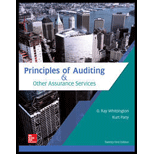
Principles Of Auditing & Other Assurance Services
21st Edition
ISBN: 9781259916984
Author: WHITTINGTON, Ray, Pany, Kurt
Publisher: Mcgraw-hill Education,
expand_more
expand_more
format_list_bulleted
Question
Chapter 21, Problem 19RQ
To determine
Explain the responsibility of the auditor for testing compliance with laws and regulations in an audit in accordance with generally accepted auditing standards.
Expert Solution & Answer
Want to see the full answer?
Check out a sample textbook solution
Students have asked these similar questions
6 Marks
Provide correct answer
I need help finding the accurate solution to this general accounting problem with valid methods.
Chapter 21 Solutions
Principles Of Auditing & Other Assurance Services
Ch. 21 - Prob. 1RQCh. 21 - Prob. 2RQCh. 21 - Prob. 3RQCh. 21 - Prob. 4RQCh. 21 - Prob. 5RQCh. 21 - Prob. 6RQCh. 21 - Prob. 7RQCh. 21 - Prob. 8RQCh. 21 - Prob. 9RQCh. 21 - Prob. 10RQ
Ch. 21 - Prob. 11RQCh. 21 - Prob. 12RQCh. 21 - Prob. 13RQCh. 21 - Prob. 14RQCh. 21 - Prob. 15RQCh. 21 - Prob. 16RQCh. 21 - Prob. 17RQCh. 21 - Prob. 18RQCh. 21 - Prob. 19RQCh. 21 - Prob. 20RQCh. 21 - Prob. 21RQCh. 21 - Prob. 22RQCh. 21 - Prob. 23RQCh. 21 - Prob. 24RQCh. 21 - Prob. 25RQCh. 21 - Prob. 26RQCh. 21 - Prob. 27RQCh. 21 - Prob. 28RQCh. 21 - Prob. 29RQCh. 21 - Explain how major federal assistance programs are...Ch. 21 - Describe what is meant by a questioned cost.Ch. 21 - Distinguish between a subrecipient and a primary...Ch. 21 - Prob. 33RQCh. 21 - Prob. 34QRACh. 21 - Steve Ankenbrandt, president of Beeb Corp., has...Ch. 21 - Prob. 36QRACh. 21 - Prob. 37QRACh. 21 - Prob. 38QRACh. 21 - Prob. 39QRACh. 21 - Prob. 40QRACh. 21 - Prob. 41QRACh. 21 - Prob. 42QRACh. 21 - Prob. 43AOQCh. 21 - Prob. 43BOQCh. 21 - Prob. 43COQCh. 21 - Prob. 43DOQCh. 21 - Prob. 43EOQCh. 21 - Prob. 43FOQCh. 21 - Prob. 43GOQCh. 21 - Prob. 43HOQCh. 21 - Prob. 43IOQCh. 21 - Prob. 43JOQCh. 21 - Prob. 43KOQCh. 21 - Prob. 43LOQCh. 21 - Prob. 44OQCh. 21 - Prob. 45OQCh. 21 - Prob. 46PCh. 21 - Devry Corporation has established an independent...Ch. 21 - Prob. 48PCh. 21 - Prob. 49PCh. 21 - Prob. 50ITC
Knowledge Booster
Similar questions
arrow_back_ios
SEE MORE QUESTIONS
arrow_forward_ios
Recommended textbooks for you
 Auditing: A Risk Based-Approach (MindTap Course L...AccountingISBN:9781337619455Author:Karla M Johnstone, Audrey A. Gramling, Larry E. RittenbergPublisher:Cengage Learning
Auditing: A Risk Based-Approach (MindTap Course L...AccountingISBN:9781337619455Author:Karla M Johnstone, Audrey A. Gramling, Larry E. RittenbergPublisher:Cengage Learning Auditing: A Risk Based-Approach to Conducting a Q...AccountingISBN:9781305080577Author:Karla M Johnstone, Audrey A. Gramling, Larry E. RittenbergPublisher:South-Western College Pub
Auditing: A Risk Based-Approach to Conducting a Q...AccountingISBN:9781305080577Author:Karla M Johnstone, Audrey A. Gramling, Larry E. RittenbergPublisher:South-Western College Pub- Business/Professional Ethics Directors/Executives...AccountingISBN:9781337485913Author:BROOKSPublisher:Cengage
 Accounting Information SystemsAccountingISBN:9781337619202Author:Hall, James A.Publisher:Cengage Learning,
Accounting Information SystemsAccountingISBN:9781337619202Author:Hall, James A.Publisher:Cengage Learning,

Auditing: A Risk Based-Approach (MindTap Course L...
Accounting
ISBN:9781337619455
Author:Karla M Johnstone, Audrey A. Gramling, Larry E. Rittenberg
Publisher:Cengage Learning


Auditing: A Risk Based-Approach to Conducting a Q...
Accounting
ISBN:9781305080577
Author:Karla M Johnstone, Audrey A. Gramling, Larry E. Rittenberg
Publisher:South-Western College Pub

Business/Professional Ethics Directors/Executives...
Accounting
ISBN:9781337485913
Author:BROOKS
Publisher:Cengage

Accounting Information Systems
Accounting
ISBN:9781337619202
Author:Hall, James A.
Publisher:Cengage Learning,